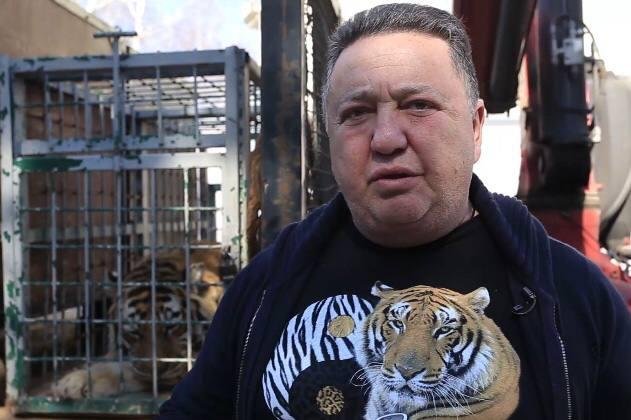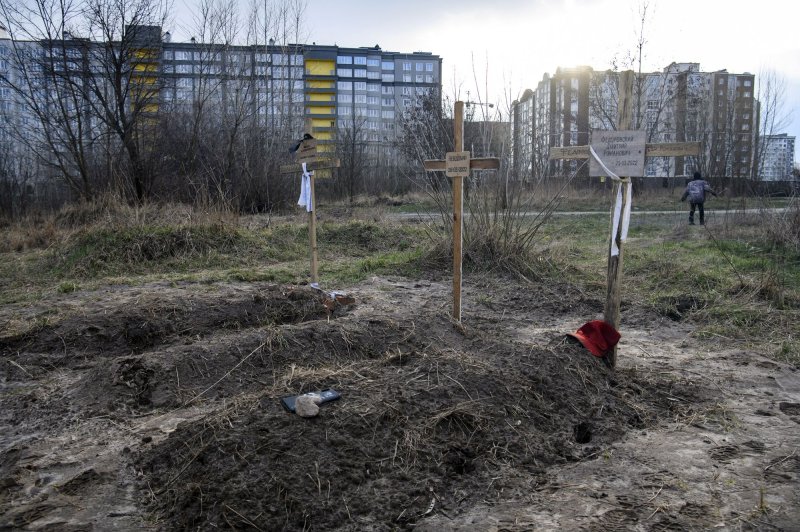PRISON NATION USA
Texas prosecutor may temporarily spare death row prisoner many believe is innocent
LONG READ
By Jolie McCullough, The Texas Tribune

John Lucio (C) tears up as he speaks at a press conference at Dallas City Hall on Friday concerning the future of his mother, Melissa Lucio, who is on death row. The family is traveling the state and joining state representatives and supporters in fighting for her freedom. Photo by Shelby Tauber/The Texas Tribune
April 12 (UPI) -- At a combative legislative hearing, the Cameron County district attorney indicated Tuesday he may step in and stop Melissa Lucio's April 27 execution, creating a new level of uncertainty in what many believe is the case of an innocent woman facing lethal injection.
Although he was not district attorney when Lucio was convicted, Cameron County District Attorney Luis Saenz did request the execution date and has the power to withdraw the request. During a heated exchange with a bipartisan group of lawmakers pushing to halt Lucio's execution, Saenz initially stated he would not intervene.
As outrage has built to a crescendo over Lucio's case, Saenz has previously stated -- and reaffirmed in the hearing -- that he stood by the process that led to Lucio's conviction and the many court rulings since that have upheld her death sentence.
But after about an hour of urging from the lawmakers, Saenz's stance shifted. He said he believes his intervention will be unnecessary because the Texas Court of Criminal Appeals will likely stop Lucio's execution. If it doesn't, he said he would, though he didn't provide details.
"If defendant Lucio does not get a stay by a certain day," he said, "then I will do what I have to do and stop it."
Because of Saenz's conflicting statements, and without any court motions or rulings, it's still not certain Lucio's execution will be stopped. Lucio's lawyer, Tivon Schardl, seemed skeptical outside the committee room but said he would take Saenz at his word. Saenz's office did not immediately respond to questions following the hearing.
State Rep. Jeff Leach, a Plano Republican and chair of the interim Criminal Justice Reform Committee, said the lawmakers would hold Saenz to his word.
"My understanding of his remarks to the committee were that if we don't get a stay or clemency issued ... then he will step in and withdraw his request for an execution date," Leach said after the hearing. "That was unequivocal to the committee, and we got it on tape."
Reasonable doubts have lingered over Lucio's guilt since the day 14 years ago she was convicted of murdering her daughter, questions that will remain even if her April execution date is canceled.
It's widely debated whether the fatal head trauma that killed 2-year-old Mariah Alvarez was an accident, and, if it wasn't, who inflicted the injury. The case against Lucio was built almost entirely around an ambiguous "confession" obtained after hours of police interrogation, and the judge at her trial barred expert testimony that might have explained why she would admit to police things she didn't do.
For now, Texas plans to execute Lucio in two weeks. She would become the first Latina executed by the state in the modern era of the death penalty and the first woman killed by Texas since 2014.
As the 53-year-old's execution date nears, concerns about her possible innocence -- greatest among them whether Mariah's death was caused by abuse or an accidental fall down the stairs -- have only been amplified.
Forestalling Lucio's impending execution has become an international cause, her name and picture splashed across newspapers and websites around the world. An ever-growing lineup of her former jurors, foreign ambassadors, celebrities and more than half of the Texas House of Representatives has urged the state parole board and governor to spare Lucio's life.
There are too many unaddressed problems with the police investigation and her trial to carry out her death sentence without more investigation, her supporters insist.
/https://static.texastribune.org/media/files/0ac5b39d3e47e46707ea635473be8bc0/Melissa%20Lucio%20Rally%20ST%20TT%2008.jpg)
State Rep. Victoria Neave Criado speaks at a rally organized at Dallas City Hall to free Melissa Lucio, a Latina mother on death row who's execution date is set to April 27, 2022. Photo by Shelby Tauber/The Texas Tribune
"The trial left me thinking Melissa Lucio was a monster, but now I see her as a human being who was made to seem evil because I didn't have all the evidence I needed to make that decision," Melissa Quintanilla, the foreperson on Lucio's jury, said in an affidavit to the parole board this week. "Ms. Lucio deserves a new trial and for a new jury to hear this evidence."
Four more of Lucio's 12 jurors have also asked the parole board and the governor to stop Lucio's execution.
Outside of court intervention or a motion from Saenz, Lucio's execution can be stopped if the Texas Board of Pardons and Paroles recommends either changing her sentence from death to life in prison or postponing the execution date for up to 120 days. Gov. Greg Abbott would have to accept the board's recommendation, which is not expected until two days before Lucio's April 27 execution date. Abbott also has the power on his own to delay the execution for 30 days, but he has never exercised that authority in a death penalty case during his time in office.
Pressure has also been mounting on Saenz to withdraw Lucio's death warrant. Before Tuesday's hearing, he indicated he did not intend to halt the execution.
"Melissa Lucio has already thoroughly litigated the issues raised during her defense, including the theories that her statement was coerced and that her two-year-old daughter Mariah Alvarez fell down the stairs. The jury rejected both of these arguments," Saenz said in a statement to The Texas Tribune last week. "As officers of the court and servants of our community, we cannot allow the rule of law to be suspended and substituted by a court of public opinion."
State and federal courts have dismissed Lucio's petitions at almost every step of the appeals process, which is meant to minimize the chance of a wrongful execution. For the prisoner's lawyers, as well as a majority of judges on a conservative federal court, some of those rejections shine a light on broader problems with the death penalty and how hard it is for courts to overturn even weak convictions.
"To these eyes, this case is a systemic failure, producing a train of injustice which only the hand of the Governor can halt," Judge Patrick Higginbotham, an appointee of President Ronald Reagan to the conservative U.S. 5th Circuit Court of Appeals, wrote in a footnote of the court's latest denial for Lucio last month.
The "confession"
In 2007, emergency personnel rushed to a Harlingen apartment newly occupied by 38-year-old Lucio, her common-law husband and nine of her 12 children. The family had called 911 after finding Mariah unresponsive in the bedroom where she had been sleeping, according to statements given to police. The toddler wasn't breathing, and her body was covered with bruises and what police believed to be a bite mark. An X-ray revealed her arm had recently been broken.
The medical examiner later concluded that Mariah was severely beaten and ruled her death a homicide caused by blunt force head trauma. At least one other pathologist who has examined the evidence since disagrees with the definitive finding of abuse and homicide.
The signs of child abuse led police to believe Mariah was murdered, and her mother -- thought to be the person most often home alone with the child -- was the prime suspect. The night of her daughter's death, Lucio told police Mariah had fallen down the steps at their old apartment a couple days earlier. She said she only saw the aftermath, so didn't know how many stairs Mariah had fallen down. At first, the child seemed fine, she said, but over time became lethargic and would not eat. Under police interrogation, pregnant with twins, Lucio vehemently and repeatedly denied ever abusing her daughter.
Until she didn't.
After about three hours denying accusations hurled by multiple police investigators, Lucio began to agree with Texas Ranger Victor Escalon, who leaned in closely and spoke softly with reassurances, a video of the interrogation shows.
Lucio said she spanked Mariah but didn't think she could have caused harm to the extent shown in the pictures of her child's body that police kept pushing in front of her. When Escalon suggested Lucio bit Mariah, Lucio shook her head. When he pushed her again, she said she did. He asked her to explain.
"What do you want me to say? I'm responsible for it," Lucio said.
For about two more hours, Lucio conceded to Escalon. She said she guessed she spanked Mariah out of frustration, a word police repeatedly suggested to her. She strongly denied responsibility for what Escalon believed was a pinch mark on Mariah's vulva, but the Ranger insisted she "get it over with." She stared at the photo of her daughter's body and then commented.
"I guess I did it," she said. When he asked how, she shrugged and said "Probably pinched her or something."
Lucio consistently denied beating Mariah across the head, however, or knocking her head in any way. But police and prosecutors believed Lucio's admissions to other abuses would lead a jury to infer she had also caused the fatal injury. They were right.
/https://static.texastribune.org/media/files/cfd23a554215fc4e447ee71e660d9ff3/Melissa%20Lucio%20Presser%20ST%20TT%2004.jpg)
John Lucio speaks at Dallas City Hall on Friday at a press conference concerning his mother's future.
Photo by Shelby Tauber/The Texas Tribune
The conviction
At trial, Escalon told the jury he knew right away that Lucio was guilty. He saw a quiet woman, slouching her head down without asking for an attorney and arrived at his personal verdict.
"Right there and then, I knew she did something," he said from the witness box.
He could tell from her body language and demeanor that she wanted to confess, he said, adding that "if you get somebody that is being honest, they're going to be upset with you."
Escalon's testimony alarmed the lawyers who would later step in to handle Lucio's appeals. Some of the techniques used in the interrogation are known to be coercive, her lawyers said, especially with vulnerable people. According to the National Registry of Exonerations, about 12% of convictions later found to be wrongful stem at least in part from false confessions.
"You've decided the person is guilty and the whole purpose is to get a statement of admission," said Vanessa Potkin, director of special litigation at The Innocence Project, who said the idea of a "human lie detector" has also been renounced.
Escalon, now the South Texas regional director for the Texas Department of Public Safety, declined to comment for this story, instead referring questions to the Cameron County district attorney's office.
Dental molds, finger nail clippings and Lucio's ring were taken to seek matches to injuries on Mariah's body, but none of the evidence was ever tested, according to trial testimony. With Lucio's interrogation statements in hand, the prosecution didn't need to test for things like DNA, the district attorney, Armando Villalobos, said at trial.
Villalobos would later be sent to federal prison for corruption in his office that occurred around the time of Lucio's trial, found to have accepted bribes for lenient prosecutorial action.
Lucio has since recanted her admissions, and supporters have long argued they were false and coerced. Lucio's lawyers intend to file new appeals based on new expert analysis that they say shows Mariah's death, as well as much of the bruising on her body, could have been caused by a fall down the stairs and subsequent head injury.
"They just kept throwing so many words at me, and I just told them I'm responsible for Mariah's bruises," Lucio said in an interview for a documentary released in 2020. "They wanted to hear something."
Lucio's advocates also argue the jury never got to hear critical testimony that could explain why Lucio, a longtime victim of sexual abuse and domestic violence, might falsely confess. State district Judge Arturo Nelson refused to allow a social worker and psychologist to testify for Lucio's innocence defense at trial.
Nelson found the clinical social worker unqualified to analyze body language -- despite Escalon having done so without listed qualifications. And he said the psychologist's expected testimony to cast doubt on Lucio's statements wasn't relevant because Lucio never admitted in the interrogation to killing her child, only abusing her.
It was that decision that rattled one of the most conservative appeals courts in the nation.
"The trial court's conclusion was inconsistent with the reality of this trial," a three-judge panel of the 5th U.S. Circuit Court of Appeals wrote in 2019. The judges added "the State's argument that Lucio struck the fatal blow relied on an inference from the statements that she abused Mariah."
In the years that followed Lucio's convictions, Texas courts rejected her petitions alleging the witnesses' exclusion kept her from presenting a complete defense of her innocence. Testimony shedding light on Lucio's body language or explaining why an abused woman would behave a certain way under police interrogation, the Texas Court of Criminal Appeals found, had little relevance to how voluntary Lucio's statement was.
In the federal appellate process, it was the 5th Circuit Court of Appeals that temporarily put the brakes on Lucio's sentence. In 2019, the three-judge panel determined the judge's decision was indeed harmful and intended to send the case back to lower courts to address the problem. But Texas asked for the full court to again weigh the case and, in a rare move, the judges accepted.
Ten of the court's 17 judges agreed to deny Lucio's appeal last year, with seven of those 10 joining an opinion that agreed with Nelson's exclusion of the witnesses. They wrote that the psychologist's report, which detailed what he was expected to testify, did "at no point ... come close even to hinting that any of these statements were false."
Three of the 10 denying judges, though, were still concerned with the trial judge's decision. But they believed their hands were tied by the Antiterrorism and Effective Death Penalty Act, a controversial 1996 federal law passed in a tough-on-crime era that limits both the allowable number of death penalty appeals as well as their paths to success.
"The [dissenting judges] express well their view that there was expert testimony that, if jurors had only heard it, could have impacted the verdict. We are all, though, working within the constraints of AEDPA," wrote Judge Leslie Southwick, a President George W. Bush appointee.
"This case, though, is a clear example that justice to a defendant may necessitate a more comprehensive review of state-court evidentiary rulings than is presently permissible," he added.
Federal appeals in death penalty cases are meant to be a check against constitutional errors by state courts, according to Rob Owen, a former death penalty law instructor at the University of Texas at Austin. Since AEDPA passed, however, federal courts can't rule independently on possible violations. Instead, Owen said, they must now defer to state courts' rulings and can correct them only if the state court has "gone wildly out of bounds."
"So ever since 1996, federal courts have been more limited in their power to correct errant state court judgements, and that's what really I think what you see in Ms. Lucio's case," he said. "There's a great risk in a case like this where a court seems to be saying there appears to be maybe an innocent person about to be executed, and we can't do anything about it."
/https://static.texastribune.org/media/files/37034fd02783d99f78ca1d18e47aaa67/Melissa%20Lucio%20Presser%20ST%20TT%2010.jpg)
John and his wife, Michelle, after a press conference in Dallas on Friday.
Photo by Shelby Tauber/The Texas Tribune
A family in trouble
The life of Lucio and her family has never been without strain. She was raised by a single mother with five siblings, and her mother's boyfriend sexually assaulted her for years starting at age 6, her lawyer reported at trial.
She got married at 16 and had five children before she was 24. Her husband was reportedly abusive physically and emotionally, and Lucio became addicted to cocaine.
After her husband abandoned her at age 26, she moved in with a new man, Robert Alvarez. She had seven more children, with Mariah being the youngest. Lucio's older children reported Alvarez abused Lucio, and a school principal once reported he saw Alvarez punch her while the family was homeless, living in a park, according to court records.
Child Protective Services was routinely involved in the family's life, with reports of neglect sometimes resulting in mediation, according to trial testimony. Lucio's lawyers reported three of Lucio's children were born with cocaine in their system, including Mariah.
Lucio and Alvarez's children were removed by the state when Mariah was two weeks old. During Mariah's time in foster care, she was found to have a physical disability that hampered her walking. Mariah had reportedly fallen on her head and been knocked unconscious in foster care. Lucio's oldest son said the child's disability was never disclosed to the family.
After two years of visitations and Lucio's repeated negative drug tests, the children were returned three months before Mariah died. Lucio told police she had been clean for a year on the night her daughter died.
Multiple children told police shortly after Mariah's death that Lucio never abused them, but they did point suspicion elsewhere for potential abuse or causes of the child's death.
They said the boys were often violent with each other and sometimes the girls, including Mariah. Foster parents reported the boys bit and hit each other while they were in their care, according to Lucio's appellate briefings. Lucio's second-oldest daughter, 20 at the time of Mariah's death, said she told police and Lucio's lawyers that her 15-year-old sister would abuse Mariah when their parents weren't around, including slamming her head on the ground a week before the child's death.
"I can remember the noise it made to this day," Daniella Lucio said in a sworn affidavit in 2018. She added that her 17-year-old brother and mother had tried to intervene in the sibling abuse, and she believed her mother admitted to the bruises because Lucio didn't want her daughter to get in trouble.
One of the children, 9 at the time, told investigators that he saw Mariah fall down the stairs. Two months before Mariah's death, a CPS case worker reported during a home visit that two of the teenaged girls were in the apartment alone with Mariah and her 3-year-old sister, according to a court briefing. The case worker noted with concern that the 3-year-old had started to go down the stairs unsupervised.
The reports from the children and CPS employee did not make it in front of the jurors, causing Lucio's family to denounce her defense attorney, Peter Gilman. They faulted him for not calling the children, even those who were adults at the time, to testify on behalf of their mother. Their skepticism heightened when Gilman accepted a job to work for the prosecutor about a year after the trial. Gilman did not respond to questions for this story.
Aside from Saenz's potential action, Lucio's lawyers plan to file new appeals in court. But after years of rejections, they are also putting hope in the hands of the Texas parole board
/https://static.texastribune.org/media/files/4c4bf912b1c17b18154ffc838d74cf14/Melissa%20Lucio%20Presser%20ST%20TT%2008.jpg)
Aaron Michaels hugs John Lucio at Dallas City Hall on Friday. Michaels is the husband of Kimberly McCarthy, who was executed on death row in 2013.
Photo by Shelby Tauber/The Texas Tribune
The parole board typically votes two days before an execution. Though it rarely recommends a delay of execution, it did so in 2019 for Rodney Reed, whose guilt is also widely doubted. The Court of Criminal Appeals stopped Reed's execution hours later, however, leaving it unknown if Abbott would have accepted the board's recommendation.
Even with the cards stacked against them, Lucio and her family remained hopeful even before Saenz's change in position. John Lucio, the prisoner's oldest son, has visited his mother regularly, he said at a public showing of the documentary on Lucio in an Austin church last month. He has been steadfast in his hope that Lucio's execution date won't come to pass, but he still has to hide his fear in his now-weekly visits to prison.
"What makes it harder is knowing that she is an innocent woman," he said last month, surrounded by family members. "Knowing the fact that we have the evidence here to show and still we can't get no help from the court systems."
John Lucio cried throughout Tuesday's hearing. Afterward, he said he wanted to believe Saenz when he said he would stop Lucio's execution if need be, but he was still asking supporters to ask the parole board and governor to take action as well.
"I want to put that faith in him and believe that he's not going to allow it to happen," he said.
Disclosure: The University of Texas at Austin has been a financial supporter of The Texas Tribune, a non-profit, non-partisan news organization that is funded in part by donations from members, foundations and corporate sponsors. Financial supporters play no role in the Tribune's journalism. Find a complete list of them here.


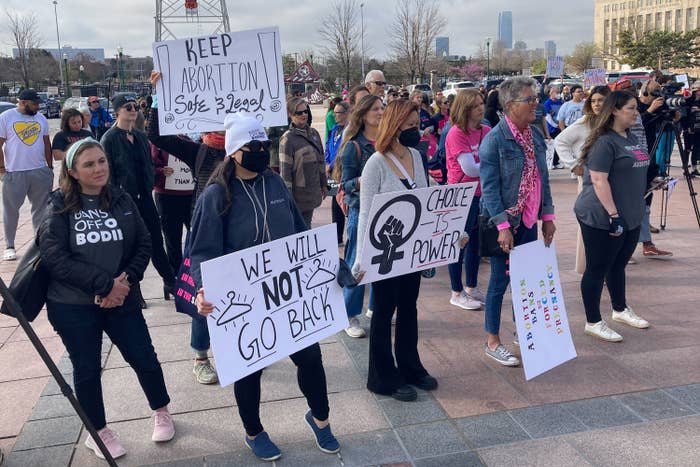
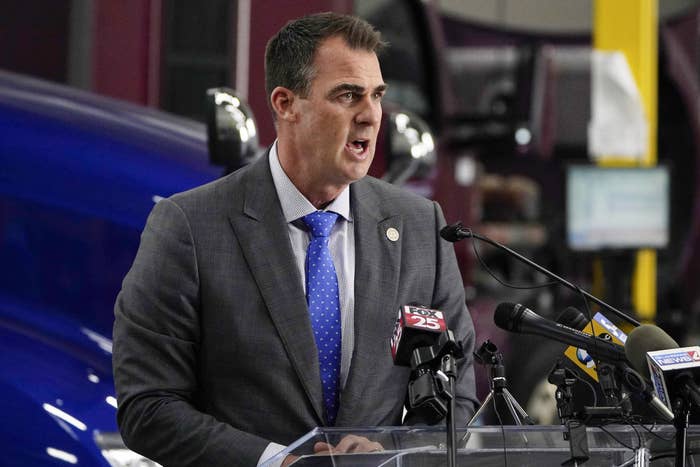
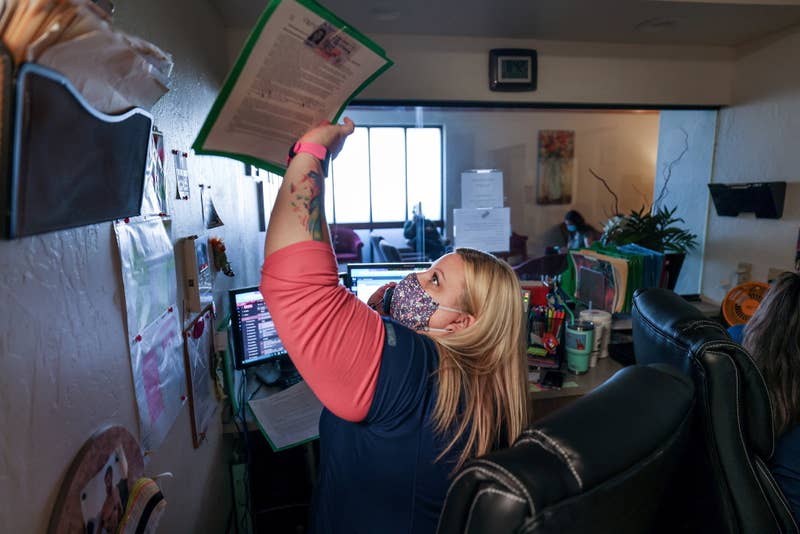



/https://static.texastribune.org/media/files/0ac5b39d3e47e46707ea635473be8bc0/Melissa%20Lucio%20Rally%20ST%20TT%2008.jpg)
/https://static.texastribune.org/media/files/cfd23a554215fc4e447ee71e660d9ff3/Melissa%20Lucio%20Presser%20ST%20TT%2004.jpg)
/https://static.texastribune.org/media/files/37034fd02783d99f78ca1d18e47aaa67/Melissa%20Lucio%20Presser%20ST%20TT%2010.jpg)
/https://static.texastribune.org/media/files/4c4bf912b1c17b18154ffc838d74cf14/Melissa%20Lucio%20Presser%20ST%20TT%2008.jpg)





